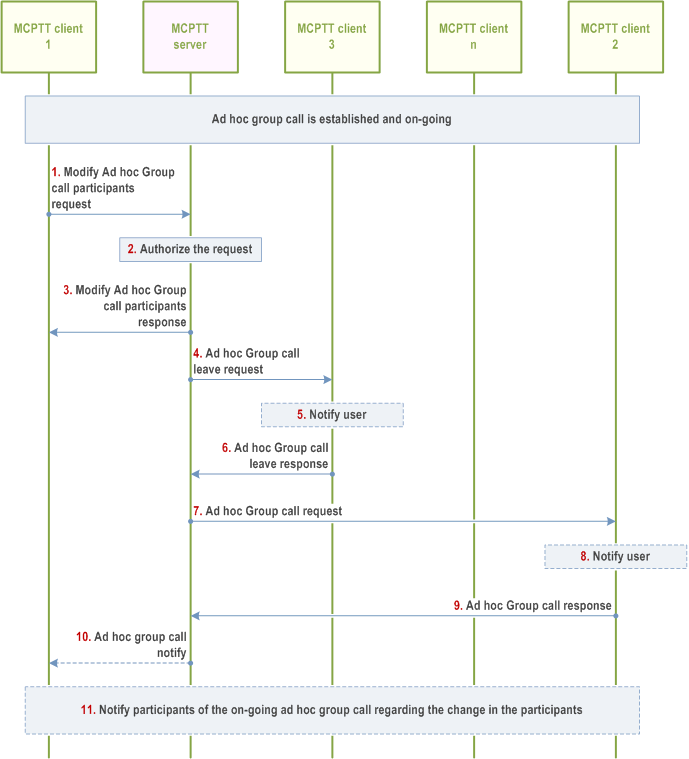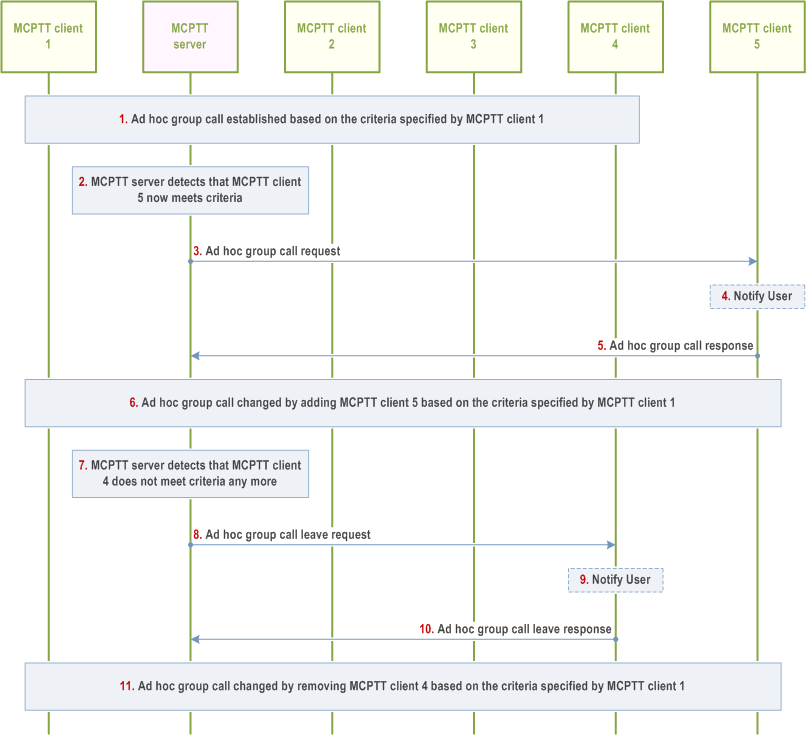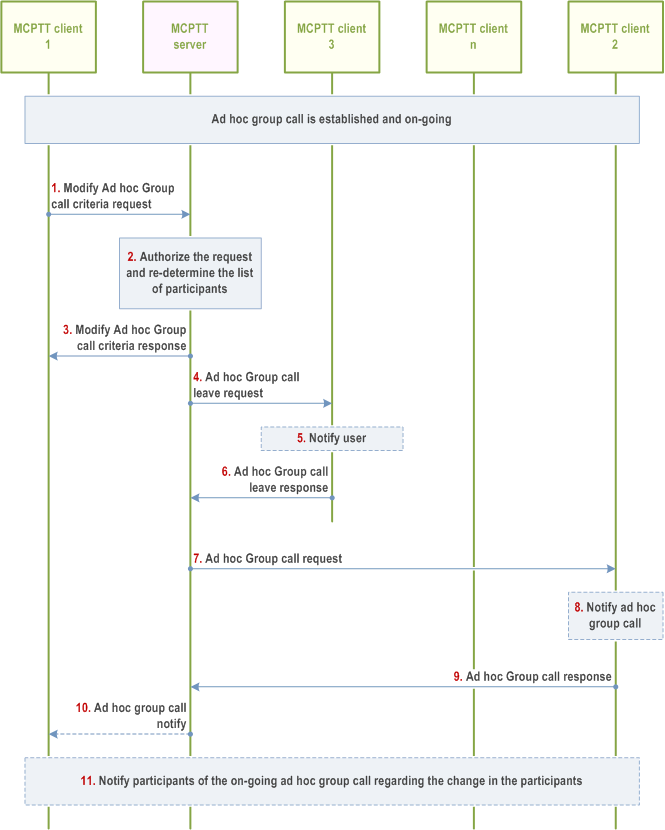Content for TS 23.379 Word version: 19.3.0
1…
7…
7.4…
10…
10.5…
10.6…
10.6.2.2.13…
10.6.2.2.24…
10.6.2.3…
10.6.2.3.1.2…
10.6.2.3.2…
10.6.2.4…
10.6.2.4.3…
10.6.2.5…
10.6.2.5.2.3…
10.6.2.6…
10.6.2.6.2…
10.6.2.7…
10.6.2.10…
10.6.3…
10.7…
10.7.2.2…
10.7.2.3…
10.7.3…
10.7.4…
10.7.5…
10.7.5.2.3a…
10.7.6…
10.7.6.2.3…
10.9…
10.9.1.3…
10.9.1.3.2…
10.9.1.3.3…
10.9.1.4…
10.9.1.5…
10.9.2…
10.9.2.6…
10.10…
10.12…
10.14…
10.15…
10.19…
10.19.2.11…
10.19.3…
10.19.3.1.4…
10.19.3.2…
10.19.3.2.4…
10.19.3.2.6…
A…
A.4…
B…
10.19.3.1.4 Modification of ad hoc group call participants by an authorized user
10.19.3.1.5 Modification of ad hoc group call participants by the MCPTT server
10.19.3.1.6 Modification of ad hoc group call criteria by an authorized user
...
...
10.19.3.1.4 Modification of ad hoc group call participants by an authorized user p. 243
Figure 10.19.3.1.4-1 below illustrates the modification of ad hoc group call participants procedure by an authorized user.
Pre-conditions:
- An ad hoc group call is already in progress and the participants list is provided by the originating MCPTT user while initiating the MCPTT ad hoc group call.
- The participants of the MCPTT ad hoc group call belong to the single MCPTT system.
- The MCPTT users on MCPTT client 1, MCPTT client 3 to MCPTT client n are on an ongoing ad hoc group call.
- The MCPTT user at MCPTT client 1 determines to remove the user of MCPTT client 3 from the ad hoc group call and add user of MCPTT client 2 into the on-going ad hoc group call.

Step 1.
The MCPTT user at the MCPTT client 1 is authorized and requests to modify ad hoc group call participants. The MCPTT client 1 sends the modify ad hoc group call participants request to the MCPTT server in order to remove MCPTT client 3 from the ongoing ad hoc group call and add MCPTT client 2 into it.
Step 2.
The MCPTT server verifies whether the MCPTT client 1 is authorized to add or remove (modify) the participants of the on-going ad hoc group call regardless of the original group call setup parameters. When the group participants were initially determined by the MCPTT server with criteria and MCPTT users are to be removed, the MCPTT server removes MCPTT clients and marks them so that the MCPTT server will not add them back to the ad hoc group call based on the criteria. Participants to be added shall be kept in the ad hoc group call and shall not be removed by the MCPTT server even if they do not meet the call criteria.
Step 3.
The MCPTT server sends modify ad hoc group call participants response to the MCPTT client 1.
Step 4.
The MCPTT server sends the ad hoc group call leave request to the MCPTT client 3 in order to remove it from the on-going ad hoc group call.
Step 5.
The MCPTT client 3 notifies the user of the ad hoc group call leave request.
Step 6.
The MCPTT client 3 sends the ad hoc group call leave response to the MCPTT server.
Step 7.
The MCPTT server sends the ad hoc group call request towards MCPTT client 2.
Step 8.
The receiving MCPTT client 2 notifies the user about the incoming ad hoc group call.
Step 9.
The MCPTT client 2 accepts the ad hoc group call request and send ad hoc group call responses to the MCPTT server. The response may also contain a functional alias of the responding MCPTT user, which is verified (valid and activated for the user) by the MCPTT server. The MCPTT server considers the MCPTT user as implicitly affiliated to the ad hoc group.
Step 10.
The MCPTT server may notify the initiating MCPTT user of all the users who are added to the on-going ad hoc group call. This notification may be sent to the initiating MCPTT user by the MCPTT server more than once during the call when MCPTT users join or leave the ad hoc group call.
Step 11.
The MCPTT server may notify the participants about the change in the participants of on-going ad hoc group call.
10.19.3.1.5 Modification of ad hoc group call participants by the MCPTT server p. 245
Figure 10.19.3.1.5-1 below illustrates the modification of ad hoc group call participants procedure by the MCPTT server.
Pre-conditions:
- The MCPTT client 1 is the initiator of the ad hoc group call.
- MCPTT server determined the participants for the ad hoc group call based on the criteria specified by the MCPTT client 1 while initiating the ad hoc group call.
- MCPTT server continuously evaluates the criteria to monitor the list of users who meets or not meets the criteria for participating in the on-going ad hoc group call.
- The MCPTT server detects that the MCPTT client 5 satisfies the criteria and MCPTT client 4 stops to meet the criteria specified by the MCPTT client 1.

Step 1.
The ad hoc group call is established and on-going with the participants MCPTT client 1, MCPTT client 2, MCPTT client 3 and MCPTT client 4. The participants list is determined by the MCPTT server based on the criteria specified by the MCPTT client 1 while initiating the call
Step 2.
The MCPTT server detects that the MCPTT client 5 satisfies the criteria specified by the MCPTT client.
Step 3.
The MCPTT server sends the ad hoc group call request to the MCPTT client 5.
Step 4.
The MCPTT client 5 notifies the user about the incoming ad hoc group call.
Step 5.
The MCPTT client 5 accepts the ad hoc group call request and sends the ad hoc group call response to the MCPTT server.
Step 6.
The on-going ad hoc group call is updated by adding MCPTT client 5 which satisfies the criteria specified by the MCPTT client 1.
Step 7.
The MCPTT server detects that the MCPTT client 4 is no more satisfying the criteria to be the participant of the ad hoc group call.
Step 8.
The MCPTT server sends the ad hoc group call leave request to the MCPTT client 4 and removes it from the on-going ad hoc group call.
Step 9.
The MCPTT client 4 notifies the user of the ad hoc group call leave request.
Step 10.
The MCPTT client 4 sends the ad hoc group call leave response to the MCPTT server.
Step 11.
The on-going ad hoc group call is updated by removing MCPTT client 4, which no more satisfies the criteria specified by the MCPTT client 1.
10.19.3.1.6 Modification of ad hoc group call criteria by an authorized user |R19| p. 247
Figure 10.19.3.1.6-1 below illustrates the modification of ad hoc group call criteria procedure by an authorized user.
Pre-conditions:
- The MCPTT user at the MCPTT client 1 is authorized to modify the criteria.
- Both the MCPTT server and the MCPTT client 1 are aware of the criteria related to the ongoing ad hoc group call.

Step 1.
The MCPTT server continuously checks whether other MCPTT clients meet or if participating MCPTT clients no longer meet the criteria for the ad hoc group emergency call.
The MCPTT user at the MCPTT client 1 is authorized and requests to modify the criteria for determining the list of participants. The MCPTT client 1 sends the modify ad hoc group call criteria request to the MCPTT server which contains an updated criteria to determine the list of participants.
Step 2.
The MCPTT server verifies whether the MCPTT client 1 is authorized to modify the criteria which determines the list of participants during on-going ad hoc group voice communication. The MCPTT server determines the list of ad hoc group call participants based on the criteria provided and indentifies that MCPTT client 3 is to be removed from and MCPTT client 2 is to be added to the group.
Step 3.
The MCPTT server sends modify ad hoc group call criteria response to MCPTT client 1.
Step 4.
The MCPTT server sends the ad hoc group call leave request to the MCPTT client 3 to remove it from the on-going ad hoc group call.
Step 5.
The MCPTT client 3 notifies the user of the ad hoc group call leave request.
Step 6.
The MCPTT client 3 sends the ad hoc group call leave response to the MCPTT server.
Step 7.
The MCPTT server sends the ad hoc group call request towards MCPTT client 2.
Step 8.
The receiving MCPTT client 2 notifies the user about the incoming ad hoc group call.
Step 9.
The MCPTT client 2 accepts the ad hoc group call request and send ad hoc group call responses to the MCPTT server. The response may also contain a functional alias of the responding MCPTT user, which is verified (valid and activated for the user) by the MCPTT server. The MCPTT server considers the MCPTT user as implicitly affiliated to the ad hoc group.
Step 10.
The MCPTT server may notify the initiating MCPTT user of all the users who are added to the on-going ad hoc group call. This notification may be sent to the initiating MCPTT user by the MCPTT server more than once during the call when MCPTT users join or leave the ad hoc group call.
Step 11.
The MCPTT server may notify the participants about the change in the participants list of on-going ad hoc group call.